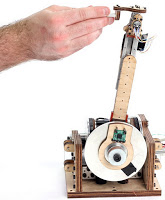 |
 |
Project Description
We present a new mechanical design for a 3-DOF haptic device with spherical kinematics (pitch, yaw, and prismatic radial). All motors are grounded in the base to decrease inertia and increase compactness near the user’s hand. An aluminum-aluminum friction differential allows for actuation of pitch and yaw with mechanical robustness while allowing a cable transmission to route through its center. This novel cabling system provides simple, compact, and high-performance actuation of the radial DOF independent of motions in pitch and yaw. We show that the device’s capabilities are suitable for general haptic rendering, as well as specialized applications of spherical kinematics such as laparoscopic surgery simulation.
This research started as a course project for CS277: Experimental Haptics, when Reuben Brewer designed, fabricated, and programmed the device in three months as the course’s capstone project. It worked surprisingly well, and it was decided to perform actual research with the device. Adam Leeper and Reuben Brewer performed a rigorous mathematical and experimental analysis of the device’s properties and how they compare to those of a commercially available haptic device, namely the Sensable Phantom Omni.
Haptic Device YouTube Video

 |
 |
 |
 |
 |
 |
Related Publications
R. D. Brewer, A. E. Leeper, and J. K. Salisbury, “A Friction Differential and Cable Transmission Design for a 3-DOF Haptic Device with Spherical Kinematics.” IEEE/RSJ International Conference on Intelligent Robots and Systems, 2011, pp. 2570-2577.
PowerPoint Presentation from IROS
GoogleDoc Presentation from IROS
Project Staff
Status
Inactive.
Funding Sources
None.